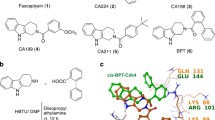Abstract
Tubulin-binding agents play a pivotal role in current cancer therapy and there are many efforts in pre-clinical and clinical development of known and novel cytotoxic agents ongoing. In this article a known class, epothilones, as well as a novel class, tubulysins, are presented.
Similar content being viewed by others
Abbreviations
- GI50:
-
concentration of 50% growth inhibition
- HUVEC:
-
human umbilical vein endothelial cell
- MCR:
-
multicomponent reaction
- MDR:
-
multiple drug resistance
References
Ganansia-Laymarie, V., Bischoff, P., Bergerat, J.-P. and Holl, V., Signal transduction pathways of taxanes-induced apoptosis, Curr. Med. Chem. – Anti-Cancer Agents, 3 (2003) 291–302.
Gerth, K., Bedorf, N., Höfle, G., Irschik, H. and Reichenbach, H., Antibiotics from gliding bacteria. 74. Epothilones A and B: Antifungal and cytotoxic compounds from Sorangium cellulosum (Myxobacteria): Production, physico-chemical and biological properties, J. Antibiotics, 49 (1996) 560–564.
Höfle, G., Bedorf, N., Steinmetz, H., Schomburg, D., Gerth, K. and Reichenbach, H., Epothilone A and B - novel 16-membered macrolides with cytotoxic activity: Isolation, crystal structure, and conformation in solution, Angew. Chem. Int. Ed. Engl., 35 (1996) 1567–1569.
Rivkin, A., Yoshimura, F., Gabarda, A.E., Chou, T.-C., Dong, H., Tong, W.P. and Danishefsky, S.J., Complex target-oriented total synthesis in the drug discovery process: The discovery of a highly promising family of second generation epothilones, J. Am. Chem. Soc., 125 (2003) 2899–2901.
Nicolaou, K.C., Sasmal, P.K., Rassias, G., Reddy, M.V., Altmann, K.-H., Wartmann, M., O’Brate, A. and Giannakakou, P., Design, synthesis, and biological properties of highly potent epothilone B analogs, Angew. Chem. Int. Ed., 42 (2003) 3515–3520.
Chou, T.-C., Dong, H., Rivkin, A., Yoshimura, F., Gabarda, A.E., Cho,Y.S., Tong, W.P. and Danishefsky, S.J., Design and total synthesis of a superior family of epothilone analogs, which eliminate xenograft tumors to a non-relapsable state, Angew. Chem. Int. Ed., 42 (2003) 4762–4767.
Wessjohann, L.A. and Scheid, G.O., Synthetic access to epothilones – natural products with extraordinary anticancer activity, In Schmalz, H.-G.(Ed.), Organic Synthesis Highlights Vol. IV, Wiley-VCH, Weinheim, 2000, pp. 251–267.
Wessjohann, L.A. and Scheid, G.O., Recent advances in chromium(II)- and chromium(III)-mediated organic synthesis, Synthesis (1999) 1-36.
Sasse, F., Steinmetz, H., Heil, J., Höfle, G. and Reichenbach, H., Tubulysins, new cytostatic peptides from myxobacteria acting on microtubuli. Production, isolation, physico-chemical and biological properties, J. Antibiot. (Tokyo), 53 (2000) 879–885.
Höfle, G., Glaser, N., Karama, U., Leibold, T., Sasse, F. and Steinmetz, H. Semisynthesis and degradation of the tubulin inhibitors epothilone and tubulysin, Pure Appl. Chem., 75 (2003) 167–178.
Schauer-Vukasinovic, V., Kaur, G., Hess, S., Höfle, G., Camalier, R., Dömling, A. and Agarwal, S., Cancer Res. (in press).
Steinmetz, H., Glaser, N., Herdtweck, E., Sasse, F. and Höfle, G., Isolation, crystal and solution structure, and biosynthesis of tubulysins – powerful inhibitors of tubulin polymerisation from myxobacteria, Angew. Chem. Intl. Ed. Engl. (in press).
Henkel, B., Beck, B., Westner, D., Mejat, B. and Dömling A., Convergent multicomponent assembly of 2-acyloxymethyl thiazoles, Tetrahedron Lett., 44 (2003) 8947–8950.
Author information
Authors and Affiliations
Corresponding author
Rights and permissions
About this article
Cite this article
Dömling, A., Richter, W. Myxobacterial epothilones and tubulysins as promising anticancer agents. Mol Divers 9, 141–147 (2005). https://doi.org/10.1007/s11030-005-1542-0
Received:
Accepted:
Issue Date:
DOI: https://doi.org/10.1007/s11030-005-1542-0




